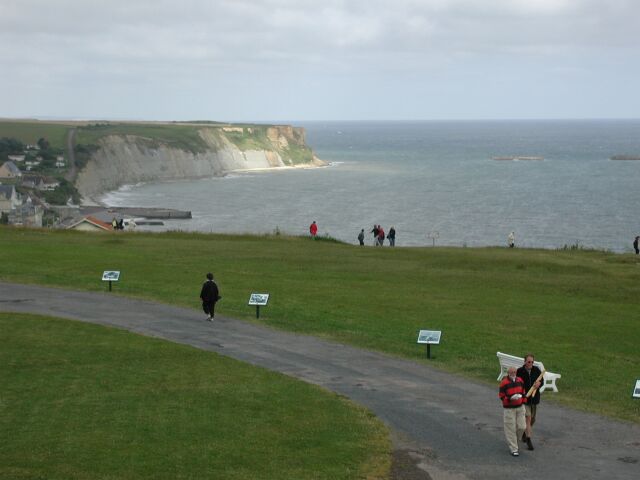
Arromanches to Cabourg
The morning in Arromanches dawned cold and dreary. I put on my rain gear and warm clothing, and thought how fortunate we had been with the weather until this morning. I stared at the cliffs that the town backed against, knowing that we would have to start the day by climbing up a steep hill. My Michelin map offered little reassurance, as the road east from Arromanches was marked ">> <<", meaning very steep. Like many hills, it was one that egged me on with curves that concealed where the real top might be. But though the hill was rather steep, it wasn't as long as some that we had or would have in the next day. We soon reached an observation turnoff that gave a view along the "Gold" beach. Even as we enjoyed the view, the sun came out to stay for the rest of the day.

Looking down on Arromanches from the top of the cliff
From here it was deliciously downhill to a series of beach resort towns that blurred together, starting with Ver-sur-mer, where we waited patiently for a bridge to rotate. We detoured off the highway over to the beach, and for a little while we were able to ride along the sea.
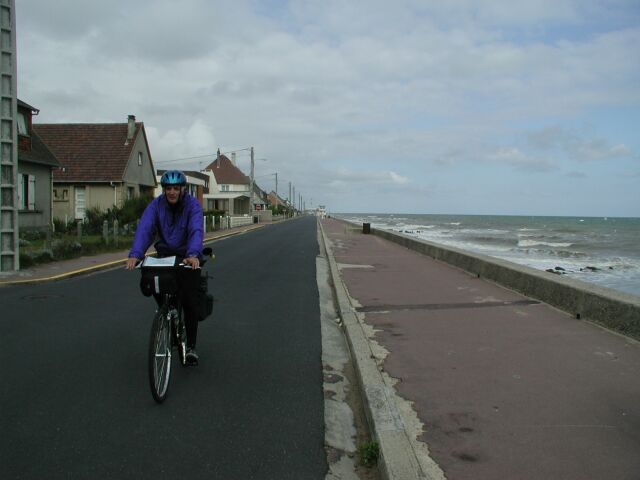
Riding the coast road in the morning
As the seaside towns melded into each other we navigated randomly, sometimes being able to ride on boardwalks, at other times taking unknown highways that paralleled the beach. Riding on one boardwalk we heard a loudspeaker blast some French at us as we passed. I recognized the word "velo", and had thefeeling it had been talking to us, but I didn't know what it had said. A block later we were stopped by a life guard, who told us that bikes were not allowed in that section. Back to the highway.
A few towns had impressive casinos facing the beach, and as we came into Courseulles-sur-mer there was a pretty inlet with a windmill and sailboats. Now this windmill was definitely in Normandy, so I took this picture.
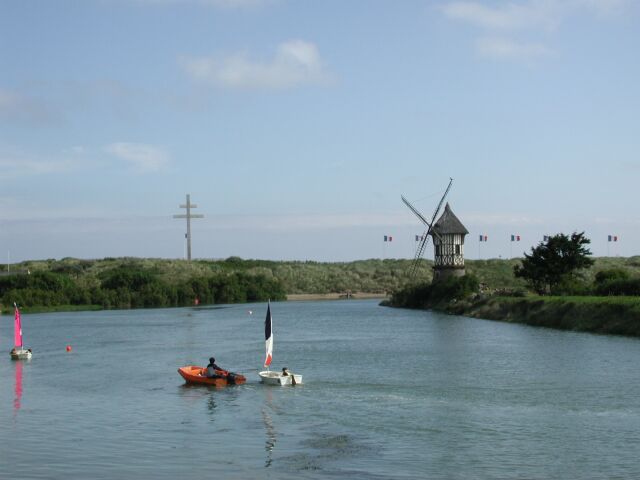
Inlet with windmill and sailboats
Len biked determinedly up a one-way street in the wrong direction. I caught up with him and we retreated. The road system seemed a bit chaotic, as no one road seemed to go through the towns along the beaches.
Coming into the next town we saw circus wagons parked alongside the road. Len turned to look, and I saw his bike hit the high curb. When I came up to him, blood was running down his leg from a cut several inches long.
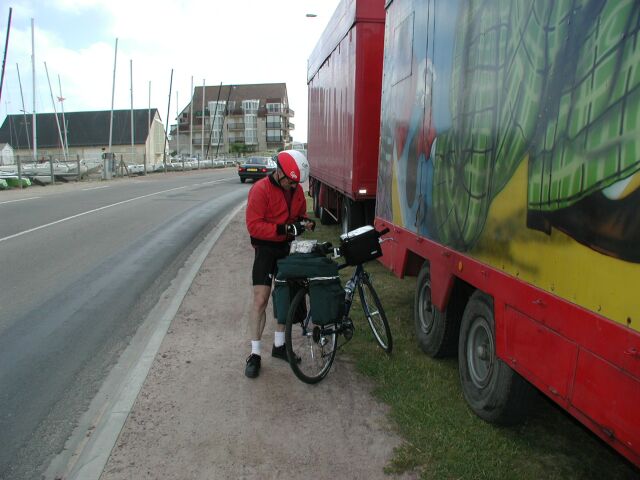
Len is distracted by the circus wagons and cuts his leg
After this mishap, we left the beach roads and took a highway inland. We kept our eyes open for a drugstore to get something for Len's leg. Presently we found one, and I waited outside while Len dealt with the pharmacy. He was gone quite a long while. I ate a peach that we had bought from a roadside stand that morning in Arromanches. While I waited, a woman came up to the pharmacy with a dog on a leash. She set the leash down at the door, and said "Stay" to the dog. Well, maybe she said "Restez" -- I assume the dog spoke French. I was impressed with the way the dog sat on his haunches, totally alert, focused on the door, and not moving a muscle as the minutes went by. Later, a man came out of the pharmacy, took the dog's leash, and off they went. This was all the entertainment that I got.
Eventually Len came out with some butterfly bandages and gauze, which we applied to the long cut. Once again we were back to the beaches, where the black clouds had temporarily blown overhead. We would have liked to bike along the boardwalks, but it was never clear when we were allowed, or whether the boardwalks were continuous or dead-ended.
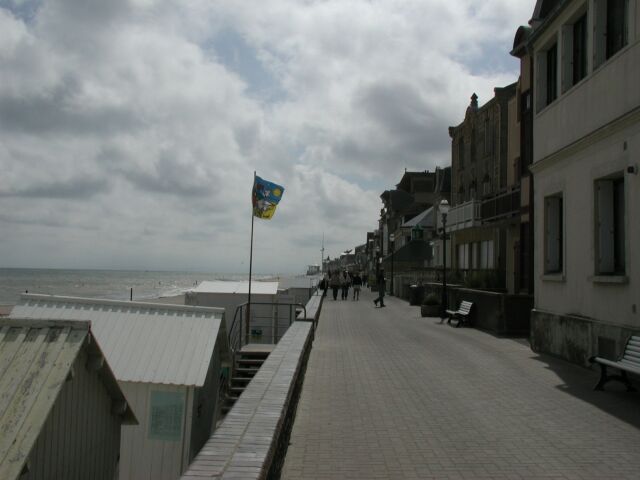
Can we bike here?
It was now lunch time, and as we followed aimless roads working our way east, we looked for a patisserie where we could buy sandwiches. Twice we went inside patisseries, only to be told that they didn't have sandwiches. Finally, entering the town of Ouistreham we found a patisserie with sandwiches, which we ate on the grass outside a public library.
The road in front of now was a puzzle. The inlet to the river Orne was ahead, and we would have to go south to get the Pegasus bridge. The problem was that the main road to this bridge was a divided highway which we couldn't bike. We would have to find an alternate road to the bridge. As we headed south on the main road, there was a sign that said bikes should follow a special marked path. We looked for subsequent signs, but saw none. Presently we were on the divided highway, and we had to go back to the previous roundabout. From there we took the most promising alternative, which was back towards the west. There we encountered a pedestrian, and when he heard the word "Pegasus" he waved us towards a side road running through wheat fields. After a few miles and another turn, we reached the Pegasus bridge, which had been made famous by its role in the D-Day invasion.
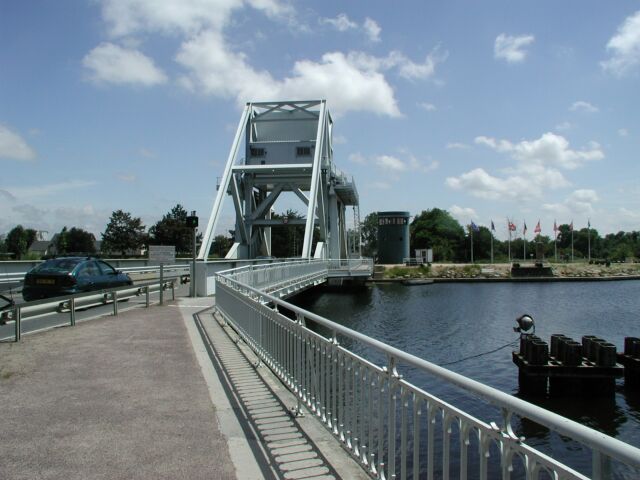
The Pegasus Bridge
It was here that in the early hours before the D-Day invasion that three British gliders crash landed with rangers to capture this bridge from the Germans. The present bridge shown in this picture is a new one, but almost an identical copy of the one that existed in 1944. The original one is on the grounds of the Pegasus Museum, which is on the opposite shore of the river here.
Len and I stopped at the museum, and spent a hour or so exploring the exhibits. There was a movie, and a guide explained the strategy and history of the attack on the bridge.
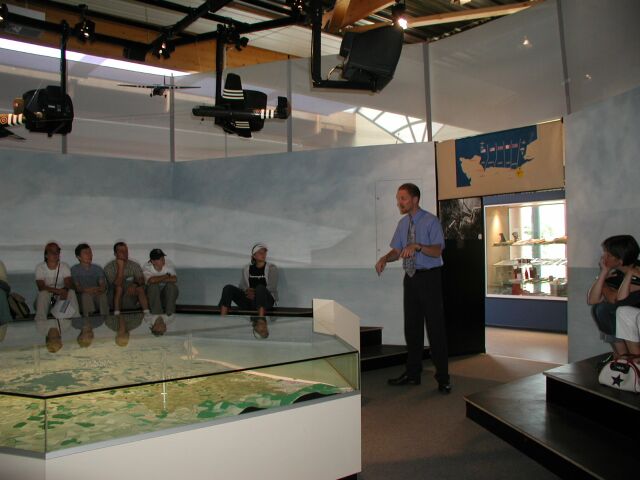
Inside the Pegasus Museum
Pointing to the model of the Normandy landscape, the guide discussed the critical position of the bridge, since it was one of only two possible paths that reinforcements could take. The bridge had to be captured before the invasion, and it was very important that the German guards there not be allowed to blow the bridge up. The wooden gliders were assembled in England and towed across the channel. Three landed close to the Pegasus bridge, one breaking up on landing. Within minutes the bridge was taken. The irony was that the Germans removed the explosives each night from the bridge to prevent their capture by the French resistance. So the guards had no opportunity to destroy the bridge when the British rangers attacked.
The guide led us outside the museum, where he pointed to the places where the gliders landed that night.
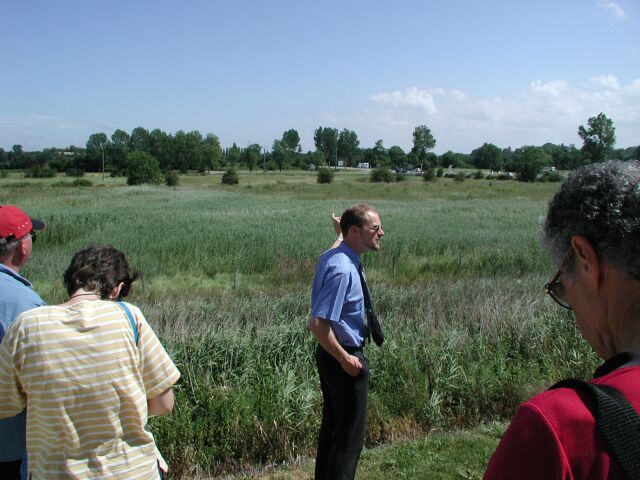
Guide points to where the gliders landed on D-Day
The guide did an excellent job, and I complimented him. It must be difficult to go through the same spiel so many times over and over again.
Back in the museum we saw various artifacts from the invasion. One that caught my eye was a military medal that had been awarded to a pigeon -- the only one ever won by a pigeon. The pigeon had been taken in a closed tube through the landing on Omaha Beach, had survived that and the subsequent fighting. When a critical gun installation had been captured, the pigeon had been released from its container. It flew through all the gunfire and found its way back to England, where it carried news of the capture of the important gun position.
Back on the road we biked up a hill on the other side of the river, and then coasted down to a flat ride into the city of Cabourg. The traffic here was fairly heavy, and for a while I was caught behind a slow biker, with no room to pass. Finally I saw an opening, and I passed. The rest of the way into the city he speeded up and tail-gated me. I guess it isn't only automobile drivers who act agressively on the road.
Cabourg is a fashionable seaside resort, twinned with Atlantic City in New Jersey, but more elegant and a little worn around the edges. It is laid out with concentric semi-circular roads. I had no idea where our hotel was. We stopped and asked a couple walking alongside the street, but they said they were British and had no idea where anything was. We turned inland and then left on one of the semi-circles, and there we were at the Hotel de Paris.
I made friends with the hotel dog who lived in the lobby. Then we went out for a walk along the main street in front of our hotel.

Main street in Cabourg
This street was a busy place, with many stores and restaurants. We walked towards the sea, looking for the best possible restaurant. At the end of the street, facing the sea, was a large casino. Some of the buildings around this area were quite elegant.

A residence in Cabourg
There was a wide boardwalk along the sea, and we walked a short ways, but at this time of day it was relatively deserted.
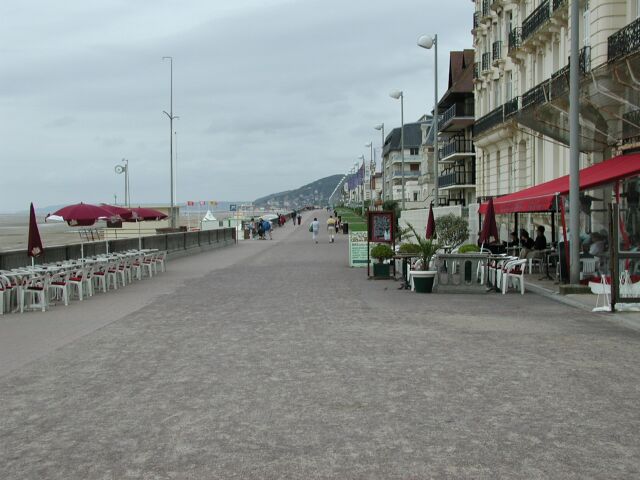
The boardwalk in Cabourg
While walking here we saw a memorable sight on the beach. A group of horses was galloping in the surf underneath flying kites, reminding us of some scene from a movie.
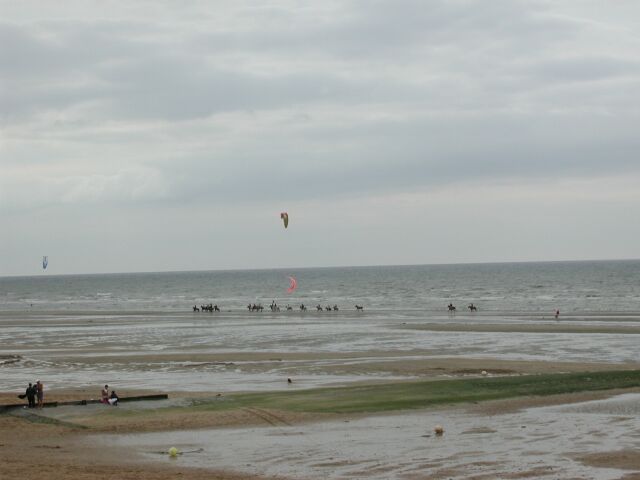
Horses gallop in the surf
We didn't see any restaurants here, so we walked back the main street towards our hotel.

Our hotel in Cabourg
A little ways down the street we settled on a restaurant, and enjoyed our reward for a day well spent.
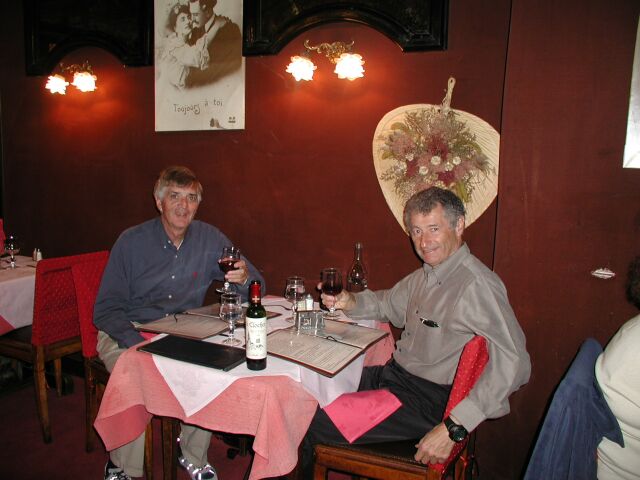
Dinner in Cabourg